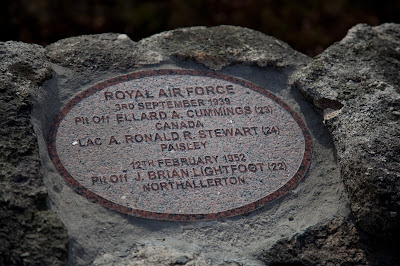Seven coffins and some stolen shrouds – By Duncan Harley
The sudden demise of Leopard Magazine a year or so ago left
a literary void in and around the North-east. My contributions to the monthly
magazine are well known but pale into insignificance when compared to the vast
reservoir of writing featured within the publications forty-plus year history as
a stand-alone monthly stalwart.
Nowadays confined to the back pages of The Scottish Field
and arguably long forgotten by a solid band of traditional readers, the
magazine’s archive forms a hotbed of surprising articles.
Over the years
since first publication in August 1974, hundreds of writers, mainly local, contributed
to Leopard. Early content ranged from farming stories by Eddie Gillanders to
Anne Tweedie’s series on the, then emerging, oil industry. North-east writer
David Toulmin’s ‘Tillycorthy Story’ and Ian Bryce’s ‘Castle of the Month’ also featured.
Interviewed in 2014 by Leopard editor Judy Mackie, founding Editor Diane Morgan recalled the early days. “Our material came from many unexpected sources” she said. “For instance, after we complained about the quality of one of our bags of coal, the coal company’s managing director came to visit us personally, and he told some marvellous stories about the old-time collier boats that delivered to Aberdeen”.
At Leopard’s 40th Birthday Party, hosted by the University of Aberdeen’s Elphinstone Institute in 2014, Diane recalled an early edition which featured a short story penned by a contributor under the pseudonym ‘Disney Kerr’.
Seemingly the writer, in reality a former postmaster residing in Portsoy, almost landed the fledgling magazine with an action for defamation. “All the characters were drawn from real life” recalls Diane, “no wonder we sold a lot of extra copies in Portsoy that month.”
The first issue of the magazine, alongside featuring editorial setting out the intent to “provide a monthly diet of well-informed reading and exciting illustrations”, included a free gift for readers in the form of a city map of Aberdeen.
However, perhaps Leopard’s real secret to early success was the inclusion of an advert extolling the virtues of an Aberdeen golf shop. Alongside some advertorial text inviting the reader to check out the shop’s “extensive range of colourful golf clothing” there stood a topless model.
That first-edition is, naturally, nowadays a sought-after collector’s item and fans of the genre were probably disappointed to discover that in the facsimile edition of the first issue, re-printed for the 40th anniversary celebrations, the model’s bare breasts had been censored and a white bar had been strategically placed across her nipples.
Interviewed in 2014 by Leopard editor Judy Mackie, founding Editor Diane Morgan recalled the early days. “Our material came from many unexpected sources” she said. “For instance, after we complained about the quality of one of our bags of coal, the coal company’s managing director came to visit us personally, and he told some marvellous stories about the old-time collier boats that delivered to Aberdeen”.
At Leopard’s 40th Birthday Party, hosted by the University of Aberdeen’s Elphinstone Institute in 2014, Diane recalled an early edition which featured a short story penned by a contributor under the pseudonym ‘Disney Kerr’.
Seemingly the writer, in reality a former postmaster residing in Portsoy, almost landed the fledgling magazine with an action for defamation. “All the characters were drawn from real life” recalls Diane, “no wonder we sold a lot of extra copies in Portsoy that month.”
The first issue of the magazine, alongside featuring editorial setting out the intent to “provide a monthly diet of well-informed reading and exciting illustrations”, included a free gift for readers in the form of a city map of Aberdeen.
However, perhaps Leopard’s real secret to early success was the inclusion of an advert extolling the virtues of an Aberdeen golf shop. Alongside some advertorial text inviting the reader to check out the shop’s “extensive range of colourful golf clothing” there stood a topless model.
That first-edition is, naturally, nowadays a sought-after collector’s item and fans of the genre were probably disappointed to discover that in the facsimile edition of the first issue, re-printed for the 40th anniversary celebrations, the model’s bare breasts had been censored and a white bar had been strategically placed across her nipples.
On looking through
my Leopard archive today, I chanced upon an article dated August 2006 and by
Norman Mackenzie headed with the word ‘Scandal’ and titled 'When the crem was a
hotbed of rumour.'
Seemingly in far
off 1944, James Dewar – a local town councillor and managing director of
Kaimhill Crematorium was put on trial for alleged malpractices relating to
thefts from the dead.
Charged with the
theft of 1,044 coffin lids, seven coffins and some shrouds, he was sentenced to
three years penal servitude – presumably to be served at Peterhead. Charges
relating to the theft of rings from the dead were seemingly dropped.
Norman Mackenzie
records in his article that Councillor Dewar resigned from the town council
following the verdict and I’m not really surprised.
The episode
inspired some to verse with one local poet penning lines as follows:
Lay that coffin down, Dewar
Lay that coffin down
Coffin pincher Dewar
Lay that coffin down
Lay that coffin down
Coffin pincher Dewar
Lay that coffin down
Wags, more intent
on satirising the event penned the likes of:
Q: Why have Aberdonians stopped drinking Dewar’s?
A: Because there’s no body in it!
A: Because there’s no body in it!
In the wake of the more recent Aberdeen Crematorium scandal it seems that there is nothing much new in
the world of those who disrespect the dead amongst us.
Nuff said perhaps ………
Nuff said perhaps ………
Duncan Harley is
author of The
A-Z of Curious Aberdeenshire plus the forthcoming title: The
Little History of Aberdeenshire- due out in March 2019












Comments
Post a Comment